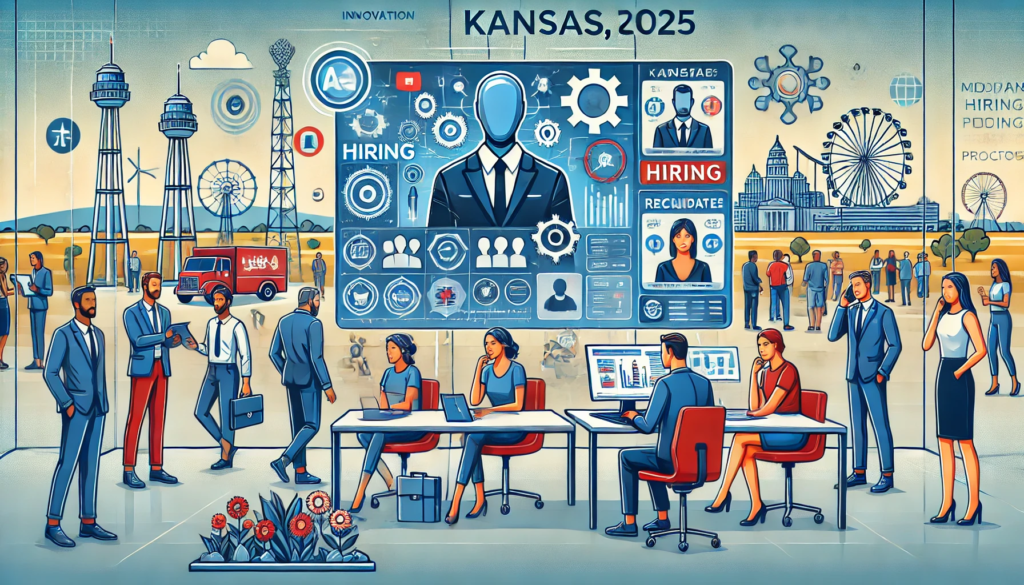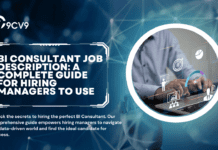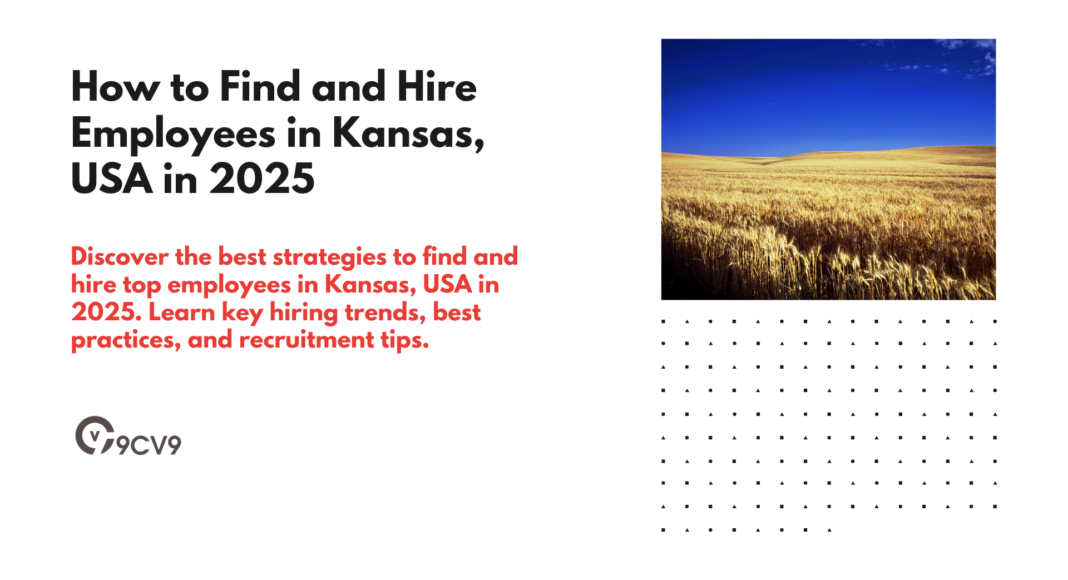Key Takeaways
- Leverage modern recruitment platforms like 9cv9 Job Portal and 9cv9 Recruitment Agency to access a wider talent pool in Kansas.
- Implement data-driven hiring strategies, including AI-powered screening and structured interviews, to improve recruitment efficiency.
- Enhance employee retention with strong onboarding, competitive benefits, and professional development programs to reduce turnover.
Hiring the right employees is one of the most critical factors in building a successful business, and in 2025, the recruitment landscape in Kansas is evolving rapidly.
With changing workforce trends, technological advancements in hiring, and an increasingly competitive job market, businesses must adopt strategic approaches to attract and retain top talent.
Whether you are a startup looking to build a strong foundation or an established company aiming to expand your workforce, understanding the hiring process in Kansas is essential to making informed recruitment decisions.

Kansas, known for its strong agricultural, manufacturing, and service-based economy, presents unique opportunities and challenges for employers.
The state’s job market has been shaped by various factors, including industry growth, demographic shifts, and government initiatives to support workforce development.
As remote work and digital transformation continue to reshape employment trends, businesses must stay ahead by leveraging innovative recruitment strategies and adapting to evolving hiring practices.
Finding and hiring employees in Kansas requires a multi-faceted approach.
Employers must first assess their hiring needs, define the ideal candidate profile, and explore multiple sourcing channels to attract the right talent.
From job boards and recruitment agencies to government workforce programs and local networking events, companies have a variety of options to connect with potential hires.
Additionally, leveraging social media and AI-powered recruitment tools can enhance efficiency in sourcing, screening, and selecting candidates.
However, attracting employees is just one part of the equation—ensuring a seamless hiring process and effective onboarding strategy is equally important.
Writing compelling job descriptions, conducting structured interviews, and adhering to employment laws in Kansas are crucial steps to ensure compliance and maintain a fair hiring process.
Moreover, offering competitive salaries, benefits, and professional development opportunities can significantly impact employee retention and workplace satisfaction.
This comprehensive guide will explore the key steps to finding and hiring employees in Kansas in 2025.
From understanding the local job market to implementing best hiring practices and optimizing employee retention strategies, this blog will provide valuable insights for employers looking to build a strong and sustainable workforce.
By adopting effective recruitment techniques and staying informed about workforce trends, businesses can position themselves for long-term success in Kansas’s dynamic employment landscape.
Before we venture further into this article, we would like to share who we are and what we do.
About 9cv9
9cv9 is a business tech startup based in Singapore and Asia, with a strong presence all over the world.
With over nine years of startup and business experience, and being highly involved in connecting with thousands of companies and startups, the 9cv9 team has listed some important learning points in this overview of How to Find and Hire Employees in Kansas, USA in 2025.
If your company needs recruitment and headhunting services to hire top-quality employees, you can use 9cv9 headhunting and recruitment services to hire top talents and candidates. Find out more here, or send over an email to [email protected].
Or just post 1 free job posting here at 9cv9 Hiring Portal in under 10 minutes.
How to Find and Hire Employees in Kansas, USA in 2025
- Understanding the Kansas Job Market in 2025
- Key Steps to Finding Employees in Kansas
- Hiring Process and Best Practices
- Onboarding and Retention Strategies
1. Understanding the Kansas Job Market in 2025
The job market in Kansas is undergoing significant transformations in 2025, shaped by various economic, demographic, and technological factors. As businesses compete to attract top talent, understanding industry trends, workforce demographics, and employment growth areas is essential for making strategic hiring decisions.
Kansas has a diverse economy, with key sectors such as agriculture, manufacturing, healthcare, and technology playing a major role in job creation. Additionally, state workforce initiatives and government policies are influencing hiring trends and providing employers with new opportunities to connect with skilled professionals.
This section explores the Kansas job market in 2025 by analyzing in-demand industries, workforce trends, and the key factors shaping employment opportunities.
Economic and Workforce Trends in Kansas (2025)
1. Employment Growth and Job Market Overview
- Kansas has maintained a stable job growth rate, with certain industries experiencing higher demand for skilled workers.
- The unemployment rate remains low, but some sectors face labor shortages due to skill gaps and workforce transitions.
- Major urban areas such as Wichita, Overland Park, and Kansas City continue to be hubs for job opportunities, while rural areas focus on agriculture and industrial employment.
2. Impact of Remote Work and Hybrid Models
- The rise of remote work has led to increased demand for digital and tech-related skills.
- Many Kansas-based businesses are adopting hybrid work models, offering flexibility to employees while maintaining in-person collaboration.
- Companies in industries such as IT, finance, and customer service are leveraging remote talent from across the U.S. while also investing in local workforce development.
3. Government and Workforce Development Programs
- The Kansas Department of Commerce has introduced new workforce training programs to address skill shortages in manufacturing, healthcare, and engineering.
- Apprenticeship programs are growing in popularity, especially in technical fields such as construction, IT, and renewable energy.
- Kansas Works, the state’s official employment platform, connects job seekers with employers and provides hiring resources for businesses.
In-Demand Industries and High-Growth Job Sectors
1. Healthcare and Medical Services
- The healthcare sector continues to be one of the fastest-growing industries in Kansas due to an aging population and increased demand for medical services.
- High-demand roles: Registered nurses, medical technicians, home health aides, and healthcare administrators.
- Example: Major hospitals such as the University of Kansas Health System and Stormont Vail Health are expanding their workforce to accommodate growing patient needs.
2. Manufacturing and Industrial Jobs
- Kansas has a strong manufacturing presence, particularly in aviation, automotive, and food processing.
- High-demand roles: Machine operators, production supervisors, industrial engineers, and quality control technicians.
- Example: Spirit AeroSystems, one of the largest aerospace manufacturers, continues to hire engineers and assembly workers to meet production demands.
3. Agriculture and Agribusiness
- As a leading agricultural state, Kansas relies on farm labor, agribusiness professionals, and food production workers.
- High-demand roles: Farm equipment operators, agricultural technicians, and food safety specialists.
- Example: Companies like Cargill and Dairy Farmers of America are hiring talent in supply chain management and agribusiness operations.
4. Information Technology (IT) and Cybersecurity
- The rise of digital transformation has increased the demand for IT professionals in various industries.
- High-demand roles: Software developers, cybersecurity analysts, IT support specialists, and data scientists.
- Example: Tech startups and companies in Kansas City’s growing tech hub are actively hiring for software development and cloud computing roles.
5. Logistics, Transportation, and E-Commerce
- With Kansas’s central location, logistics and transportation remain crucial for economic growth.
- High-demand roles: Truck drivers, warehouse managers, supply chain analysts, and e-commerce fulfillment specialists.
- Example: Amazon and UPS have expanded distribution centers in Kansas, creating thousands of jobs in logistics and delivery services.
6. Renewable Energy and Sustainability
- Kansas is investing in wind and solar energy projects, leading to job creation in the clean energy sector.
- High-demand roles: Wind turbine technicians, solar panel installers, and environmental engineers.
- Example: Evergy, the state’s largest energy provider, is expanding its renewable energy workforce to meet sustainability goals.
Key Hiring Challenges and Opportunities for Employers
1. Workforce Skill Gaps and Talent Shortages
- Certain industries, such as manufacturing and healthcare, face challenges in finding skilled workers due to changing job requirements.
- Employers are addressing these gaps by partnering with local colleges and vocational schools to provide job-specific training programs.
- Example: The Kansas Board of Regents has launched initiatives to equip students with technical skills in high-demand industries.
2. Competition for Top Talent
- With a growing number of job openings, businesses must offer competitive salaries, benefits, and career growth opportunities to attract and retain employees.
- Companies are focusing on strong employer branding and workplace culture to stand out in a competitive market.
3. Diversity and Inclusion in Hiring
- Businesses are prioritizing diversity, equity, and inclusion (DEI) initiatives to create a more inclusive workforce.
- Example: Many Kansas employers are actively recruiting veterans, individuals with disabilities, and underrepresented groups to enhance workplace diversity.
4. Retention and Employee Engagement Strategies
- Beyond hiring, retaining employees is a key challenge, especially in industries with high turnover rates.
- Companies are implementing professional development programs, mentorship initiatives, and employee wellness programs to improve job satisfaction.
Conclusion
Understanding the Kansas job market in 2025 requires a comprehensive view of employment trends, industry demands, and workforce development initiatives. Employers must stay informed about high-growth sectors, address skill shortages, and adopt competitive hiring strategies to attract top talent. By leveraging local resources, government programs, and innovative recruitment methods, businesses can build a strong workforce and drive long-term success in Kansas’s evolving employment landscape.
2. Key Steps to Finding Employees in Kansas
Finding the right employees in Kansas requires a well-planned hiring strategy that aligns with current labor market trends, employer needs, and workforce expectations. In 2025, businesses must leverage multiple recruitment channels, optimize job postings, and utilize advanced hiring technologies to attract top talent.
With growing competition for skilled professionals across industries, employers must adopt a comprehensive approach that includes digital job portals, recruitment agencies, networking events, and workforce development programs. Platforms like 9cv9 Job Portal and services from 9cv9 Recruitment Agency provide businesses with effective solutions to streamline the hiring process and connect with qualified candidates in Kansas.
This section outlines the essential steps to finding employees in Kansas, including sourcing strategies, employer branding, and innovative recruitment techniques.
1. Define Hiring Needs and Job Requirements
Before starting the hiring process, businesses must clearly define their workforce needs to ensure they attract the right candidates.
Assess Workforce Gaps
- Identify specific roles and skills needed within the company.
- Analyze past hiring challenges to refine recruitment strategies.
- Evaluate whether to hire full-time employees, part-time workers, or contractors based on business goals.
Create Comprehensive Job Descriptions
- Outline key responsibilities, qualifications, and expected experience levels.
- Highlight company culture, benefits, and career growth opportunities to attract top candidates.
- Ensure job descriptions are SEO-optimized with relevant keywords to improve visibility on job portals like 9cv9 Job Portal and other hiring platforms.
Determine Salary and Benefits Package
- Research industry-standard compensation packages in Kansas using salary benchmarking tools.
- Offer competitive wages, health benefits, flexible work arrangements, and professional development opportunities to attract high-quality candidates.
- Include remote work or hybrid options for roles that allow it.
2. Utilize Job Portals and Online Hiring Platforms
Digital job portals are one of the most effective ways to connect with job seekers in Kansas.
Post Jobs on Leading Employment Platforms
- Use platforms like 9cv9 Job Portal, Indeed, Glassdoor, and LinkedIn to reach a wide audience of candidates.
- Optimize job listings with targeted keywords to improve search rankings and applicant engagement.
- Utilize advanced filtering tools on 9cv9 Job Portal to screen candidates efficiently based on skills, experience, and location.
Leverage AI-Powered Recruitment Tools
- Use AI-driven job-matching algorithms to connect with the most suitable candidates.
- Implement chatbots and automated pre-screening assessments to streamline the hiring process.
- Analyze recruitment data to refine hiring strategies and optimize future job postings.
Example: A Kansas-based tech company used 9cv9 Job Portal to post software engineering roles and successfully hired experienced developers within a few weeks using AI-driven candidate recommendations.
3. Partner with Recruitment Agencies for Specialized Hiring
Recruitment agencies can provide businesses with expert hiring solutions, particularly for specialized or hard-to-fill roles.
Work with Industry-Specific Recruitment Agencies
- Consider partnering with 9cv9 Recruitment Agency for end-to-end hiring support, including candidate sourcing, pre-screening, and interview coordination.
- Recruitment firms can help fill roles in healthcare, IT, manufacturing, and other high-demand industries.
- Agencies provide access to both active and passive job seekers, expanding the talent pool.
Utilize Staffing Solutions for Temporary and Contract Hiring
- Staffing agencies help businesses quickly find short-term or seasonal employees.
- Temporary staffing solutions are useful for industries with fluctuating workforce needs, such as retail, logistics, and hospitality.
Example: A Wichita-based logistics company struggling to fill warehouse roles collaborated with 9cv9 Recruitment Agency, successfully hiring skilled workers within two weeks.
4. Expand Hiring Efforts Through Local Networking and Events
Engaging with local job seekers through networking events and job fairs can help employers build strong connections with potential candidates.
Participate in Kansas Job Fairs and Hiring Events
- Attend statewide hiring events, such as the KansasWorks Virtual Job Fairs and industry-specific career expos.
- Engage with college graduates at university-hosted career fairs to attract young professionals.
- Set up booths at local trade shows to promote job openings and employer branding.
Connect with Kansas Workforce Development Centers
- Utilize state-sponsored job centers to access job listings, training programs, and employer resources.
- Partner with Kansas WorkforceONE to connect with job seekers undergoing skills training and career development.
Example: A healthcare provider in Overland Park hired multiple nursing assistants after attending a Kansas Healthcare Career Expo, where they directly interacted with job seekers.
5. Leverage Social Media for Recruitment
Social media platforms are valuable tools for finding and engaging with potential employees.
Use LinkedIn for Professional Hiring
- Post job openings and company updates on LinkedIn to attract skilled professionals.
- Use LinkedIn’s recruiter search to proactively reach out to top candidates.
- Encourage employees to share job postings within their professional networks.
Utilize Facebook, Twitter, and Instagram for Employer Branding
- Share employee testimonials, workplace culture content, and company achievements to build a strong employer brand.
- Engage with potential hires through social media job groups and targeted job advertisements.
Example: A Kansas retail company successfully hired a marketing specialist by promoting job openings on LinkedIn and engaging with candidates through social media comments.
6. Implement Employee Referral Programs
Encouraging current employees to refer qualified candidates can be an effective hiring strategy.
Create a Structured Employee Referral Program
- Offer cash bonuses, extra vacation days, or gift cards for successful referrals.
- Clearly communicate referral guidelines and eligibility requirements.
- Utilize internal platforms where employees can easily submit referrals.
Example: A Kansas-based IT firm filled multiple software engineering positions within a month using a $500 referral bonus program, resulting in high-quality hires.
7. Attract Candidates with Strong Employer Branding
A strong employer brand helps businesses stand out in a competitive job market.
Develop an Engaging Careers Page on Your Website
- Include employee testimonials, company mission, and workplace benefits.
- Showcase office culture through photos and videos to attract candidates.
- Ensure job applications are mobile-friendly for easy submission.
Highlight Diversity and Inclusion Initiatives
- Promote DEI programs to attract candidates from diverse backgrounds.
- Showcase employee success stories and leadership opportunities.
Example: A manufacturing company in Topeka improved its hiring rate by revamping its careers page and highlighting employee development programs.
8. Optimize the Hiring Process for Efficiency
A streamlined hiring process improves candidate experience and ensures timely recruitment.
Use Applicant Tracking Systems (ATS)
- Automate resume screening and application tracking to save time.
- Identify top candidates faster with AI-driven ATS solutions.
Conduct Structured Interviews
- Use a mix of behavioral, technical, and situational interview questions.
- Implement panel interviews for critical roles to ensure better decision-making.
Example: A Kansas startup reduced hiring time by 40% by implementing an ATS and structured interview process.
Conclusion
Finding employees in Kansas in 2025 requires a combination of digital recruitment strategies, networking efforts, and employer branding initiatives. Platforms like 9cv9 Job Portal provide employers with access to a wide talent pool, while 9cv9 Recruitment Agency offers specialized hiring support to fill critical roles efficiently. By leveraging job portals, recruitment agencies, social media, and workforce development programs, businesses can attract and retain top talent in Kansas’s evolving job market.
3. Hiring Process and Best Practices
Hiring employees in Kansas in 2025 requires an optimized and structured approach to attract, assess, and retain top talent. With the evolving job market, businesses must adopt best practices that align with industry trends, legal requirements, and candidate expectations.
An effective hiring process ensures that employers select the right candidates efficiently while maintaining compliance with local and federal labor laws. Leveraging modern recruitment tools, refining interview techniques, and enhancing the onboarding experience are essential to successful hiring.
This section outlines the step-by-step hiring process and best practices for businesses looking to hire employees in Kansas.
1. Defining the Hiring Strategy
Before launching the recruitment process, companies should establish a clear hiring strategy that aligns with business objectives and workforce needs.
Assess Workforce Requirements
- Identify skills gaps within the organization and forecast future hiring needs.
- Determine whether full-time, part-time, contract, or remote workers are required.
- Evaluate internal promotions and upskilling options before hiring externally.
Develop a Clear Hiring Timeline
- Set realistic deadlines for each stage of the hiring process.
- Plan for seasonal workforce demands (e.g., retail and logistics hiring surges during holidays).
- Establish key performance indicators (KPIs) to measure recruitment efficiency.
Example: A Kansas-based IT company identified a need for software developers and planned a three-month hiring process, integrating AI-powered screening tools to expedite candidate selection.
2. Crafting Effective Job Descriptions
Well-structured job descriptions attract the right candidates and improve visibility on job boards.
Key Components of a Job Description
- Job Title: Use clear, industry-recognized titles for easy searchability.
- Responsibilities: Outline key tasks and daily duties in bullet points.
- Qualifications: Specify required education, experience, and technical skills.
- Salary & Benefits: Include competitive compensation details, health benefits, and perks.
- Company Culture & Growth Opportunities: Highlight career advancement options.
Optimize for SEO and Job Portals
- Use keywords that job seekers frequently search for (e.g., “Remote Software Developer in Kansas” or “Warehouse Associate Hiring in Wichita”).
- Format job postings for easy readability on mobile and desktop platforms.
- Utilize 9cv9 Job Portal and other recruitment sites to maximize job listing visibility.
Example: A manufacturing firm in Kansas increased applicant engagement by 30% after optimizing job descriptions with relevant industry keywords and posting on 9cv9 Job Portal.
3. Leveraging Recruitment Channels
Employers must utilize diverse recruitment channels to attract the best candidates.
Online Job Portals
- Post job listings on platforms like 9cv9 Job Portal, Indeed, and LinkedIn.
- Use paid job advertisements to target specific demographics.
- Filter applications using AI-driven screening tools.
Recruitment Agencies
- Partner with 9cv9 Recruitment Agency for sourcing pre-screened candidates.
- Leverage staffing agencies for temporary or seasonal hiring.
- Use headhunting services for senior-level and specialized roles.
Social Media Recruitment
- Share job openings on LinkedIn, Facebook, and Twitter.
- Use employee advocacy programs where staff members refer candidates via social networks.
- Engage with talent communities and professional groups.
Example: A Kansas healthcare provider successfully hired experienced nurses by combining 9cv9 Recruitment Agency services with targeted LinkedIn recruitment campaigns.
4. Screening and Shortlisting Candidates
Efficient screening processes help identify the most qualified candidates.
Application Screening
- Use Applicant Tracking Systems (ATS) to filter resumes based on qualifications and keywords.
- Implement AI-powered recruitment tools to match candidate profiles with job requirements.
- Assign weighted scores to resumes to rank applicants objectively.
Pre-Employment Assessments
- Conduct skills tests for technical roles (e.g., coding tests for developers).
- Use behavioral assessments to evaluate problem-solving and teamwork abilities.
- Implement situational judgment tests to assess real-world decision-making skills.
Example: A Kansas logistics company reduced hiring time by 40% by automating resume screening and conducting pre-hire skills assessments.
5. Conducting Effective Interviews
Structured interviews help employers evaluate candidates consistently.
Best Practices for Interviews
- Prepare a standardized list of questions for fair evaluation.
- Use behavioral interview techniques (e.g., “Tell me about a time you handled workplace conflict”).
- Implement structured scoring systems to rate candidate responses.
Types of Interviews
- Phone Screenings: Initial discussions to verify basic qualifications.
- Video Interviews: Used for remote candidates or first-round evaluations.
- Panel Interviews: Multiple interviewers assess candidates for managerial and specialized roles.
- Technical Interviews: Conducted for IT, engineering, and skilled trades positions.
Example: A Kansas fintech startup improved hiring decisions by incorporating structured video interviews and AI-powered candidate assessments.
6. Making the Job Offer
A strong job offer ensures a higher acceptance rate from top candidates.
Key Elements of a Job Offer
- Clearly outline salary, benefits, work hours, and job expectations.
- Provide a written offer letter with detailed employment terms.
- Set a deadline for offer acceptance to maintain hiring timelines.
Negotiation Strategies
- Be prepared to discuss salary expectations and benefits.
- Offer flexible working arrangements if requested by candidates.
- Highlight long-term career growth opportunities within the company.
Example: A Kansas-based e-commerce company increased offer acceptance rates by 25% by personalizing job offers and providing signing bonuses for high-demand roles.
7. Ensuring a Smooth Onboarding Process
An effective onboarding process helps new hires integrate seamlessly into the company.
Pre-Onboarding Preparations
- Provide digital onboarding portals for paperwork and company policies.
- Assign mentors or onboarding buddies for new hires.
- Set up email accounts and necessary work equipment before the first day.
First Week Orientation
- Conduct virtual or in-person orientation sessions.
- Introduce new hires to team members and key stakeholders.
- Provide an overview of job expectations and company culture.
Continuous Onboarding and Training
- Schedule regular check-ins during the first 90 days.
- Offer training sessions to upskill employees and improve job performance.
- Gather feedback to refine the onboarding experience.
Example: A Kansas-based marketing agency improved new hire retention by 40% by implementing a structured onboarding program with mentorship support.
8. Ensuring Compliance with Kansas Hiring Laws
Businesses must follow federal and state employment laws to maintain compliance.
Key Legal Considerations
- Equal Employment Opportunity (EEO): Ensure non-discriminatory hiring practices.
- Kansas Minimum Wage Laws: Stay updated on state-mandated wages and employee benefits.
- Work Authorization: Verify employee eligibility using E-Verify and Form I-9.
Employee Rights and Benefits
- Provide proper documentation on paid leave policies, overtime regulations, and workplace safety.
- Comply with Kansas Workers’ Compensation Laws to cover workplace injuries.
- Adhere to federal and state background check regulations.
Example: A retail company in Topeka avoided legal penalties by regularly updating HR policies to align with Kansas labor laws.
Conclusion
Optimizing the hiring process in Kansas in 2025 requires a combination of structured recruitment strategies, best practices, and compliance with state regulations. Businesses can enhance their hiring success by leveraging platforms like 9cv9 Job Portal for job postings and 9cv9 Recruitment Agency for specialized hiring support.
By following best practices—such as using AI-powered screening tools, conducting structured interviews, and implementing effective onboarding—companies can attract, hire, and retain top talent in Kansas’s evolving job market.
4. Onboarding and Retention Strategies
A well-structured onboarding and retention strategy is essential for businesses in Kansas to secure top talent and maintain long-term employee engagement. The modern workforce expects more than just a salary; they seek professional growth, a positive workplace culture, and work-life balance.
Companies that invest in strong onboarding programs can reduce employee turnover and enhance productivity. Additionally, effective retention strategies ensure that employees remain engaged, motivated, and loyal to the organization.
This section explores best practices for onboarding and employee retention in Kansas in 2025, helping businesses create a thriving workplace.
1. Creating a Structured Onboarding Process
A smooth onboarding experience ensures that new hires integrate seamlessly into the company and become productive quickly.
Pre-Onboarding Preparations
- Send a welcome email with essential details about the company, job role, and first-day schedule.
- Provide access to digital onboarding portals where employees can complete paperwork before their start date.
- Assign a designated mentor or onboarding buddy to guide the new hire.
- Ensure workspace setup (IT equipment, login credentials, access badges) is ready before the employee’s first day.
Example: A Kansas-based tech startup reduced onboarding time by 50% by implementing an automated onboarding system that allowed employees to complete administrative tasks online before their first day.
Day One Orientation Program
- Conduct an interactive orientation session to introduce company values, mission, and culture.
- Provide a company handbook outlining workplace policies, benefits, and performance expectations.
- Introduce new hires to their team members and key stakeholders to foster connections.
- Offer a tour of the office or virtual workspace walkthrough for remote employees.
Example: A Wichita-based financial firm improved new hire engagement by incorporating gamified onboarding activities to familiarize employees with company policies and culture.
First 30-90 Days: Training and Development
- Schedule regular check-ins with HR and direct managers to address concerns.
- Implement role-specific training to ensure new hires acquire the necessary skills.
- Encourage collaborative projects to help employees integrate with their teams.
- Provide access to learning management systems (LMS) for self-paced training modules.
Example: A manufacturing company in Topeka increased first-year retention rates by 35% by offering a structured 90-day onboarding program that included mentorship and job shadowing.
2. Building a Positive Workplace Culture
A strong workplace culture fosters employee engagement and long-term retention.
Encouraging Open Communication
- Maintain a transparent feedback culture where employees feel comfortable sharing concerns.
- Implement monthly town hall meetings to discuss company updates and gather employee input.
- Use pulse surveys to assess employee satisfaction and address issues proactively.
Promoting Diversity, Equity, and Inclusion (DEI)
- Establish DEI programs to create an inclusive work environment.
- Offer unconscious bias training for managers and hiring teams.
- Support employee resource groups (ERGs) that promote workplace diversity.
Example: A Kansas-based retail chain improved employee engagement by launching a DEI initiative that included mentorship programs for underrepresented groups.
Recognizing and Rewarding Employees
- Implement an employee recognition program that highlights achievements and contributions.
- Offer monetary incentives, bonuses, and promotions to reward high performance.
- Celebrate work anniversaries and milestones to make employees feel valued.
Example: A Kansas City healthcare provider reduced employee turnover by 20% by introducing a peer recognition platform where colleagues could publicly appreciate each other’s contributions.
3. Providing Competitive Compensation and Benefits
Attractive compensation and benefits play a crucial role in employee retention.
Competitive Salary Packages
- Conduct market salary benchmarking to ensure competitive pay structures.
- Offer annual salary reviews to adjust for inflation and industry standards.
- Provide performance-based bonuses and profit-sharing programs.
Comprehensive Benefits Offerings
- Offer healthcare benefits, including medical, dental, and vision coverage.
- Provide retirement plans such as 401(k) with employer matching contributions.
- Include paid parental leave and family support programs.
Example: A Kansas law firm improved employee retention by offering student loan repayment assistance, attracting younger professionals seeking financial stability.
Work-Life Balance Initiatives
- Implement flexible work arrangements, including remote and hybrid work options.
- Encourage paid time off (PTO) policies that promote employee well-being.
- Provide mental health resources and wellness programs.
Example: A software company in Overland Park saw a 30% improvement in employee satisfaction by introducing a four-day workweek pilot program.
4. Career Growth and Professional Development
Providing employees with opportunities for career advancement enhances long-term retention.
Internal Promotion Opportunities
- Develop a succession planning strategy to promote from within.
- Encourage employees to apply for internal job openings before hiring externally.
- Provide leadership development programs to prepare employees for managerial roles.
Example: A Kansas logistics firm increased retention rates by 40% by implementing an internal career mobility program that allowed employees to transition into new roles.
Ongoing Learning and Development
- Offer tuition reimbursement programs for employees pursuing higher education.
- Provide online courses and certifications relevant to employees’ career paths.
- Encourage cross-training opportunities to develop diverse skill sets.
Example: A Wichita engineering company partnered with local universities to sponsor employee certification programs, increasing engagement and retention.
5. Creating a Strong Employee Engagement Strategy
Engaged employees are more likely to remain with a company long-term.
Encouraging Employee Involvement
- Establish employee advisory boards where staff can contribute to company decisions.
- Organize team-building activities to foster collaboration and camaraderie.
- Host corporate social responsibility (CSR) events that align with employees’ values.
Regular Performance Reviews and Feedback
- Conduct quarterly performance evaluations to discuss career goals and development plans.
- Implement 360-degree feedback systems where employees receive input from peers, managers, and subordinates.
- Set clear key performance indicators (KPIs) for career progression.
Example: A Kansas City marketing agency saw a 25% increase in employee retention by shifting to a continuous performance feedback model rather than annual reviews.
6. Retaining Talent Through Exit Interviews and Retention Analysis
Understanding why employees leave can help companies improve retention.
Conducting Effective Exit Interviews
- Identify trends in why employees are leaving (e.g., lack of career growth, compensation concerns).
- Gather honest feedback to refine company policies and work culture.
- Offer stay interviews to address potential retention risks before employees consider leaving.
Using Data Analytics for Retention Insights
- Monitor employee turnover rates and track retention metrics.
- Use HR analytics tools to identify departments with high attrition.
- Implement predictive analytics to proactively address retention challenges.
Example: A Kansas-based insurance company reduced turnover by 30% by using AI-driven analytics to identify early signs of employee dissatisfaction.
Conclusion
A robust onboarding and retention strategy is vital for businesses in Kansas looking to secure and sustain a skilled workforce in 2025. Companies that implement structured onboarding, foster a positive workplace culture, provide competitive benefits, invest in career development, and leverage HR analytics will improve employee engagement and reduce turnover.
By adopting these best practices, Kansas-based employers can attract top talent, enhance job satisfaction, and build a high-performing workforce that drives long-term business success.
Conclusion
As businesses in Kansas navigate the evolving job market in 2025, finding and hiring the right employees requires a strategic, data-driven, and candidate-centric approach. Employers must adapt to changing workforce trends, leverage modern recruitment tools, and build an attractive employer brand to stay ahead in the competitive hiring landscape.
Kansas offers a diverse labor market with talent spanning various industries, from agriculture and manufacturing to technology, healthcare, and finance. However, hiring success depends on a company’s ability to effectively source, evaluate, onboard, and retain employees.
By implementing best practices in recruitment and retention, businesses can build a strong, skilled, and committed workforce that contributes to long-term growth and stability. Below is a comprehensive summary of the key takeaways and best strategies for hiring employees in Kansas in 2025.
Key Takeaways for Hiring Employees in Kansas in 2025
1. Understanding the Kansas Job Market
- Kansas boasts a diverse workforce, with growing demand in sectors such as technology, healthcare, logistics, and renewable energy.
- Remote and hybrid work models are becoming more prevalent, requiring businesses to adapt recruitment strategies.
- Wage expectations and competitive benefits play a crucial role in attracting skilled professionals.
- The aging workforce in traditional industries highlights the need for succession planning and talent pipeline development.
2. Leveraging Modern Recruitment Channels
- Online job portals like 9cv9 Job Portal and networking platforms such as LinkedIn are essential for reaching a broader talent pool.
- Recruitment agencies like 9cv9 Recruitment Agency can streamline the hiring process, providing access to pre-vetted candidates.
- Employee referrals and internal hiring programs enhance recruitment success by leveraging existing talent networks.
- University partnerships and apprenticeship programs help attract young professionals and recent graduates.
3. Implementing an Effective Hiring Process
- Clearly defining job roles and skill requirements ensures targeted recruitment.
- Crafting compelling job descriptions improves application rates by attracting the right candidates.
- Leveraging AI-driven recruitment tools enhances efficiency in screening and shortlisting applicants.
- Structured interview processes, skill assessments, and behavioral evaluations lead to better hiring decisions.
- Prioritizing cultural fit and employee values ensures long-term retention and organizational harmony.
4. Enhancing Onboarding and Employee Retention
- A well-structured onboarding process helps new employees integrate quickly and boosts productivity.
- Offering competitive salaries, benefits, and work-life balance initiatives attracts and retains top talent.
- Career development programs, mentorship, and leadership training foster employee engagement and job satisfaction.
- Creating a positive workplace culture with strong DEI (Diversity, Equity, and Inclusion) initiativesimproves employee morale and loyalty.
- Regular performance feedback, recognition programs, and internal mobility opportunities contribute to long-term employee retention.
Best Practices for Sustainable Workforce Growth in Kansas
1. Strengthening Employer Branding
- Companies must build a strong online presence to showcase their culture, mission, and career opportunities.
- Encouraging employee advocacy through testimonials and social media engagement enhances credibility.
- Offering workplace flexibility and progressive policies attracts modern professionals seeking work-life balance.
2. Utilizing Data-Driven Hiring Strategies
- HR analytics and AI-powered insights help businesses refine hiring strategies based on market trends.
- Predictive hiring models identify high-potential candidates and reduce turnover risks.
- Surveying employees and conducting stay interviews provide insights into workforce satisfaction and engagement levels.
3. Adapting to Future Workforce Trends
- The rise of automation and AI-driven recruitment will continue to reshape hiring processes.
- Remote hiring and virtual onboarding solutions will remain essential in the post-pandemic workforce.
- Upskilling and reskilling programs will be crucial for businesses aiming to future-proof their workforce.
- Corporate social responsibility (CSR) initiatives and sustainability efforts will play a role in attracting socially-conscious job seekers.
Final Thoughts: Achieving Hiring Success in Kansas in 2025
Finding and hiring employees in Kansas in 2025 requires a combination of traditional hiring expertise and modern technological advancements. Businesses must embrace digital recruitment platforms, leverage AI-powered hiring tools, and foster an engaging workplace culture to attract and retain top talent.
By partnering with recruitment agencies like 9cv9 Recruitment Agency, utilizing job portals such as 9cv9 Job Portal, and adopting innovative hiring solutions, Kansas employers can streamline their recruitment process and gain a competitive edge in the job market.
Ultimately, the key to long-term hiring success lies in continuous adaptation, employee-centric strategies, and a commitment to workforce development. By prioritizing talent acquisition, engagement, and retention, companies in Kansas can build a resilient, future-ready workforce that drives sustainable business growth.
If you find this article useful, why not share it with your hiring manager and C-level suite friends and also leave a nice comment below?
We, at the 9cv9 Research Team, strive to bring the latest and most meaningful data, guides, and statistics to your doorstep.
To get access to top-quality guides, click over to 9cv9 Blog.
People Also Ask
What are the best ways to find employees in Kansas in 2025?
Utilize job portals like 9cv9 Job Portal, recruitment agencies, social media hiring, employee referrals, and networking events to attract top talent.
Which industries are hiring the most in Kansas in 2025?
Key industries include healthcare, technology, manufacturing, agriculture, and logistics, with a growing demand for skilled professionals in these sectors.
How can I attract top talent in Kansas?
Offer competitive salaries, flexible work arrangements, strong benefits, and career development opportunities to attract and retain high-quality employees.
What job portals are best for hiring in Kansas?
Top job portals include 9cv9 Job Portal, Indeed, LinkedIn, and Glassdoor, offering access to a wide range of candidates across industries.
Is it better to use a recruitment agency in Kansas?
Yes, recruitment agencies like 9cv9 Recruitment Agency streamline hiring by sourcing, screening, and matching the best candidates for your business needs.
How do I create an effective job posting in Kansas?
Write a clear job description, highlight key responsibilities, mention required skills, offer competitive benefits, and use SEO keywords to increase visibility.
What are the legal requirements for hiring employees in Kansas?
Employers must comply with federal and state labor laws, including minimum wage regulations, employee classification, and anti-discrimination policies.
What are the key hiring trends in Kansas for 2025?
Remote work flexibility, AI-driven recruitment, skill-based hiring, and increased focus on diversity and inclusion are key hiring trends in Kansas.
How can small businesses compete for top talent in Kansas?
Small businesses can offer competitive salaries, flexible work environments, career growth opportunities, and a strong company culture to attract employees.
What are the common hiring challenges in Kansas?
Challenges include a competitive job market, talent shortages in certain industries, high employee expectations, and evolving workplace trends.
How do I screen candidates effectively?
Use AI-driven applicant tracking systems, conduct structured interviews, assess relevant skills, and verify references to ensure a strong hiring decision.
What salary expectations should I consider in Kansas?
Salaries vary by industry, but offering competitive wages, performance-based incentives, and benefits can help attract top candidates.
How important is employer branding in Kansas?
Strong employer branding helps businesses attract and retain top talent by showcasing a positive work culture, career growth, and employee benefits.
What are the best interview techniques for hiring in Kansas?
Use behavioral interview questions, structured assessments, and real-world job simulations to evaluate candidate skills and cultural fit.
Is remote work popular among Kansas employees in 2025?
Yes, remote and hybrid work options are in demand, and offering flexible work arrangements can help businesses attract a wider talent pool.
How do I ensure diversity and inclusion in my hiring process?
Implement unbiased screening methods, diverse interview panels, and inclusive job descriptions to foster a diverse and equitable workforce.
What role does AI play in hiring in Kansas?
AI-driven recruitment tools help with resume screening, candidate matching, and interview scheduling, making the hiring process more efficient.
How long does the hiring process take in Kansas?
The hiring timeline varies by industry but typically takes two to six weeks, depending on job complexity and candidate availability.
What are the benefits of using 9cv9 Job Portal for hiring in Kansas?
9cv9 Job Portal offers a large candidate database, AI-driven recruitment, and advanced job posting features to streamline hiring.
How do I retain employees in Kansas?
Offer competitive salaries, career growth opportunities, work-life balance, and a positive work environment to boost employee retention.
What are effective employee onboarding strategies?
Provide clear job training, mentorship programs, and structured onboarding sessions to help new hires integrate smoothly into the company.
How can I speed up the hiring process in Kansas?
Use applicant tracking systems, conduct pre-screening interviews, and leverage recruitment agencies like 9cv9 Recruitment Agency to speed up hiring.
What are the top soft skills employers look for in Kansas?
Employers prioritize communication, teamwork, problem-solving, adaptability, and leadership skills in candidates across industries.
What background checks are required when hiring in Kansas?
Employers may conduct criminal background checks, employment verification, education verification, and reference checks as part of the hiring process.
How can I reduce employee turnover in Kansas?
Provide a strong company culture, career development opportunities, work-life balance, and competitive compensation to improve employee retention.
What benefits should Kansas employers offer in 2025?
Health insurance, retirement plans, paid leave, remote work options, and professional development programs are key benefits to attract employees.
How do I write a job offer letter in Kansas?
Include job title, salary, benefits, start date, work schedule, and employment terms in a clear and professional job offer letter.
What are the best networking strategies to find employees in Kansas?
Attend job fairs, connect with local universities, leverage LinkedIn networking, and participate in industry events to find potential hires.
How do I handle counteroffers from candidates?
Assess the candidate’s value, consider matching or improving the offer, and highlight long-term benefits to encourage acceptance.
How can Kansas businesses use social media for hiring?
Post job openings on LinkedIn, Facebook, and Twitter, engage with potential candidates, and showcase company culture to attract talent.































![Writing A Good CV [6 Tips To Improve Your CV] 6 Tips To Improve Your CV](https://blog.9cv9.com/wp-content/uploads/2020/06/2020-06-02-2-100x70.png)


